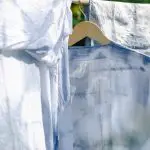For non-washable items, try these effective deodorizing methods. Sprinkle baking soda on the fabric and let it sit to absorb odors. Use a vinegar spray solution to neutralize smells, and consider placing activated charcoal nearby for additional absorption. Essential oil fresheners can also provide a pleasant scent. If needed, look into professional deodorization services for persistent odors. Want to explore more tips and techniques? Keep going for detailed insights!
Table of Contents
Key Takeaways
- Sprinkle baking soda on non-washable fabrics to absorb odors, let it sit for 15 minutes, then shake or vacuum off the excess.
- Use a vinegar spray solution (1 part vinegar to 3 parts water) to neutralize odors and freshen fabric without damage.
- Place activated charcoal in breathable containers near fabrics to trap odor-causing particles effectively.
- Mist upholstery and delicate fabrics with fabric fresheners for a quick scent boost and odor masking.
- Regularly air out non-washable items to enhance freshness and reduce odor retention after cleaning methods.
Baking Soda Deodorizing Technique
One simple and effective way to deodorize fabric is by using baking soda. Just sprinkle a generous amount onto the fabric you want to refresh.
Let it sit for at least 15 minutes, or longer for tougher odors. Baking soda absorbs unpleasant smells, leaving your fabric smelling fresher.
For best results, let baking soda sit for at least 15 minutes to effectively absorb odors and refresh your fabric.
After the time’s up, shake off the excess powder or use a vacuum with a brush attachment to remove it completely. If your fabric allows, you can also lightly rub the baking soda into the material for deeper penetration.
This method’s great for items like upholstery, cushions, or even shoes. Plus, it’s non-toxic and safe to use around pets and kids.
You’ll notice a significant difference in odor!
Essential Oil Freshening Method
When it comes to freshening up fabrics with essential oils, choosing the right scents is key.
You’ll want to mix them properly to create a pleasant aroma that lasts.
Let’s explore the best application methods to guarantee your fabrics smell great!
Choosing the Right Oils
Selecting the right essential oils can greatly enhance the cleanliness of your fabrics, so it’s important to take into account both the scent and the properties of each oil.
Here are three oils you might consider:
- Lavender: Known for its calming scent, lavender can help reduce stress and create a soothing atmosphere while deodorizing fabrics effectively.
- Tea Tree: With its antibacterial properties, tea tree oil not only refreshes but also helps eliminate odors caused by bacteria, making it a great choice for workout gear.
- Lemon: This bright, invigorating scent can uplift your space and combat unpleasant smells, leaving your fabrics feeling revitalized.
Mixing Techniques Explained
Mixing essential oils for deodorizing fabrics can be both an art and a science, allowing you to create personalized scents that suit your preferences.
Start by selecting a base oil, like lavender or lemon, that’s known for its freshening properties. Then, add complementary oils, such as eucalyptus or tea tree, to enhance the fragrance and boost deodorizing effects.
Aim for a balanced blend—typically, one part base oil to one part complementary oils works well. Remember to test small quantities first to ascertain the scent meets your expectations.
Keep track of your ratios so you can replicate your favorite mixtures. With practice, you’ll master the technique and enjoy custom scents that keep your non-washable items smelling fresh.
Application Methods Overview
After creating your custom essential oil blends, applying them effectively is key to achieving lasting cleanliness in your fabrics.
Here are three application methods to contemplate:
- Spray Method: Fill a spray bottle with your blend and lightly mist the fabric from a distance. This helps distribute the scent evenly without soaking the material.
- Soaking Method: For items like upholstery, lightly dampen a cloth with your essential oil blend, then press it onto the fabric. This method allows for deeper scent penetration.
- Diffusion Method: Use a diffuser nearby to disperse the essential oil aroma into the air, subtly revitalizing the surrounding fabrics over time.
Choose the method that best suits your non-washable items, and enjoy the invigorating scents!
Vinegar Spray Solution
If you’re looking for a natural way to freshen up your fabrics, vinegar is a fantastic option.
Mixing vinegar with water creates a powerful spray that neutralizes odors effectively.
Let’s explore the benefits of vinegar for fabrics, how to mix your solution, and the best application techniques to guarantee maximum effectiveness.
Vinegar Benefits for Fabrics
While many commercial fabric deodorizers contain harsh chemicals, vinegar offers a natural and effective alternative for freshening up your fabrics.
Using vinegar can provide several benefits:
- Odor Neutralization: Vinegar breaks down odor-causing bacteria, leaving your fabrics smelling fresh.
- Stain Removal: It acts as a natural stain fighter, helping to lift and remove unwanted marks without damaging the fabric.
- Fabric Softening: Vinegar helps soften fabrics, making them feel comfortable and pleasant against your skin.
Incorporating vinegar into your fabric care routine not only enhances freshness but also reduces reliance on synthetic products.
Mixing Vinegar and Water
To harness the benefits of vinegar for deodorizing fabrics, mixing it with water creates a versatile spray solution that’s easy to use.
Start with a ratio of one part vinegar to three parts water in a clean spray bottle. This combination helps neutralize odors while being gentle on most fabrics.
Shake the bottle well to guarantee the mixture is blended, and you’re ready to go! Vinegar’s natural acidity cuts through smells, leaving your items fresher.
Remember, it’s a good idea to test a small, inconspicuous area of the fabric first to guarantee there’s no discoloration.
This simple solution not only deodorizes but also helps eliminate bacteria, making it a fantastic choice for non-washable items around your home.
Application Techniques for Effectiveness
When you’re ready to apply the vinegar spray solution, start by confirming the fabric is clean and dry for the best results.
Follow these steps for effective application:
- Spray Evenly: Hold the spray bottle about 6-8 inches away from the fabric and spray evenly, avoiding saturation. This allows the solution to penetrate without soaking the material.
- Test First: Before applying to the entire area, test a small, inconspicuous spot to confirm the fabric won’t react negatively.
- Air Dry: After spraying, let the fabric air dry completely. This helps the vinegar’s odor dissipate while neutralizing unwanted smells.
Activated Charcoal Absorption
Activated charcoal is a powerful ally in the battle against unwanted odors in fabrics. Its porous structure allows it to trap and absorb odor-causing particles effectively.
To use activated charcoal, simply place it in a breathable pouch or container and position it near the fabric you want to deodorize. You can leave it there for several hours or even a few days, depending on the severity of the odor.
Remember to refresh the charcoal regularly by exposing it to sunlight, which reactivates its absorbing properties. This natural method not only eliminates odors but also helps maintain a fresh environment without using harsh chemicals.
With activated charcoal, you can confidently tackle stubborn smells in your non-washable items.
Fabric Refresher Sprays
After utilizing activated charcoal for odor absorption, consider enhancing your fabric’s freshness with fabric refresher sprays.
These sprays can quickly revitalize your items without the need for washing, making them ideal for non-washable fabrics.
Here are three reasons to use fabric refresher sprays:
- Instant Freshness: Just a quick spritz can eliminate odors, leaving your fabric smelling clean and pleasant.
- Variety of Scents: You can choose from a range of fragrances, allowing you to customize the scent to your preference.
- Easy Application: Simply spray, let it dry, and enjoy the refreshed smell without any hassle.
Using fabric refresher sprays can keep your items smelling great between washes, combining convenience with effectiveness.
Steam Cleaning Approach
Although you might think washing is the only way to rid fabric of odors, steam cleaning offers an effective alternative that can revive your items without the hassle of a full wash. This method uses high-temperature steam to penetrate the fabric, loosening dirt and neutralizing odors.
By targeting the source of the smell, you can refresh items like upholstery, curtains, or delicate clothing without risking damage.
To steam clean, simply use a handheld steamer or a steam cleaning machine. Move the steamer slowly over the fabric, allowing the steam to work its magic. Make sure to follow the manufacturer’s instructions for best results.
After steaming, let the fabric air out; you’ll be amazed at how fresh and revitalized your items can feel!
Dry Cleaning Alternatives
If you’re looking for effective ways to eliminate odors from your fabrics without resorting to traditional dry cleaning, several alternatives can do the trick.
Here are three methods you can try:
- Baking Soda: Sprinkle baking soda on the fabric and let it sit for a few hours before vacuuming. It absorbs odors effectively.
- Fabric Fresheners: Use a fabric refresher spray designed for upholstery and delicate fabrics. Just lightly mist the area, and the scent will help mask odors.
- Vinegar Solution: Mix equal parts water and white vinegar in a spray bottle. Lightly mist the fabric and allow it to air dry. The vinegar will neutralize odors without leaving a strong scent behind.
With these methods, you can keep your non-washable fabrics fresh and odor-free!
Professional Deodorization Services
When odors persist despite your best efforts, professional deodorization services can provide a powerful solution.
These experts use advanced techniques and specialized equipment to tackle stubborn smells that regular cleaning mightn’t eliminate. They assess the fabric type and odor source, ensuring a tailored approach for your items.
Professional deodorization experts utilize specialized equipment and tailored techniques to effectively eliminate stubborn odors from your items.
From ozone treatments to steam cleaning, these services penetrate deep into fibers, lifting odors effectively without damaging your belongings.
You won’t have to worry about harsh chemicals; many professionals use eco-friendly options that are safe for both your fabrics and the environment.
Investing in professional deodorization can save you time and frustration, leaving your non-washable items smelling fresh and revitalized.
Frequently Asked Questions
Can I Use These Methods on Delicate Fabrics?
You can use these methods on delicate fabrics, but test a small area first. Some fabrics might react differently, so proceed with caution to avoid damage. Always prioritize the fabric’s care instructions for the best results.
How Long Should I Let Deodorizing Agents Sit?
Imagine letting sunlight warm a room—it’s best to let deodorizing agents sit for at least 15-30 minutes. This allows them to absorb odors and refresh fabrics, just like sunlight brightens and revitalizes your space.
Are There Any Safety Concerns With These Methods?
Yes, there are safety concerns. You should always test a small area first, guarantee proper ventilation, and avoid using harsh chemicals that can irritate skin or harm fabrics. Follow product instructions carefully to minimize risks.
Can I Combine Different Deodorizing Techniques?
Sure, you can combine different deodorizing techniques! Experimenting with various methods often enhances effectiveness. Just make sure to test a small area first, so you don’t accidentally damage the fabric or create unwanted reactions.
How Often Should I Deodorize Non-Washable Items?
You might think deodorizing isn’t necessary, but it is! Aim to freshen non-washable items every few weeks, or more often if you notice odors. Regular care keeps your belongings smelling great and looking their best.
- Does Chiffon Fabric Stink - July 15, 2025
- Does Chiffon Fabric Affect the Economy - July 15, 2025
- Does Cotton Fabric Have a Nap - July 15, 2025







